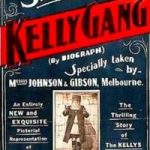Silent films are often given a wonky reputation by modern cinema buffs. Whenever we think of the genre, we immediately conjure up images of clownish-looking performers behaving like mimes having a seizure, or production designs and direction that are so unnatural and dated that you can’t help but laugh, or roll your eyes at its unintentional silliness. By today’s standards, silent films are looked down upon as a dead genre, only ever being acknowledged during academic studies or analytical mockery. The cinema fans of today rarely warm up to classic cinema the same way they would warm up to Deadpool (2016) or Moonlight (2016).
The Story of the Kelly Gang is certainly nothing like the stereotypical silent films that we think of. Though more than 100 years old, the film is one of those cinematic masterpieces that gets riper with age, and offers enough entertainment value that you find yourself getting as invested in it as you would a Michael Bay flick, or a Peter Jackson epic.
Based on true events (and possibly a popular history play written by Arnold Denham), the film follows the life of Ned Kelly (Frank Mills), as a heated brawl with a rowdy constable forces him, his brother Dan (John Forde), and their mates Steve Hart and Joe Byrne (J. Ennis and Will Coyne), to flee and lay low in the Wombat Ranges, in hope of escaping the authorities. But things go from bad to worse when the four of them unintentionally shoot and kill a trio of police officers set out to hunt them down, resulting in Kelly and his crew becoming wanted murderers. We follow the exploits of the men (now calling themselves “The Kelly Gang”), as they spend months and months on the run, robbing banks, holding up homesteads, and hoodwink their pursuers, as their deeds slowly build up to a violent confrontation at Glenrowan.
When it premiered on Boxing Day 1906, the film — with its offering of adventure, action, mateship, epic history, and relatable characters — became an immediate hit, receiving high praise from critics and audience members alike. Anyone who saw it back then were captivated by this retelling of the country’s most notorious figure, and years later, the film still continues to captivate, even if only a quarter of it survives today. During its original release, The Story of the Kelly Gang ran at 60-70 minutes long — the first time a film had ever ran at that length (prior to Kelly Gang, films only ran for 6-10 minutes in length). But after several years of poor handling and storing, a majority of the film has been destroyed or misplaced, leaving us with only 15 minutes of surviving footage. But nonetheless, what we do have is still cinema at its finest!

The direction of Charles Tait is masterfully handled and perfectly staged, always leaving you in awe at how professionally shot all the scenes are, especially at a time when filmmaking was still a relatively young and unknown medium. At every chance he got, Tait allowed his creativity and passion for the piece to flourish, creating Australian cinema’s most iconic sequences (my personal favourite scene has got to be the climactic siege at Glenrowan and Ned Kelly’s last stand — the part of the Kelly legend that everyone comes to see).
The cast give first-class performances, managing to find a perfect mixture of largeness and subtlety, without ever becoming over-the-top or comical with their gestures and expressions. They are bombastic and dramatic in their delivery, but still succeed in portraying natural human beings and natural human behaviour (a far cry from the stereotypical Lon Chaney or Charlie Chaplin style of acting that is always associated with films from the silent era).
The locations have got to be the film’s best feature though. Shot in Heidelberg, Eltham, Greensborough, Rosanna, Mitcham and St Kilda, the natural backdrops of rolling hills, mysterious forests and vibrant homesteads add a breathtaking beauty to every scene, making you feel as if you’re watching a Frederick McCubbin painting come to life. The locations (and even the scenes inside the Glenrowan Inn, which were filmed on a soundstage) are enough to make the film an intoxicating work of art, as well as an entertaining period piece. The Story of the Kelly Gang is practically a testament to what a beautiful country Australia really is.
Though many silent films appear to fail to age well as cinema continues to develop, Charles Tait’s magnum opus about one of our most famous Australians undoubtably defies the odds and remains just as exciting as it was back in 1906. With the exception of a fire scene during the Glenrowan sequence (where the whole screen is adorably covered in a red gel to simulate an inferno), nothing about The Story of the Kelly Gang feels dated at all, nor does it give reason to succumb to the same put downs that most films from the silent era receive from 21st century film goers. Even in its half-complete state, it still offers so much when it comes to entertainment value. Definitely a film you must see before you die — especially if you’re a fore-mentioned silent film cynic who believes that the genre does not have the same impact as the films of today. Be prepared to be pleasantly surprised.
Fun Fact:
Ned Kelly’s actual suit of armour was borrowed from the Victorian Museum and worn in the film.
To see Nathan’s reviews of other classic (and not so classic) Ned Kelly-related films, go here.





COMMENTS